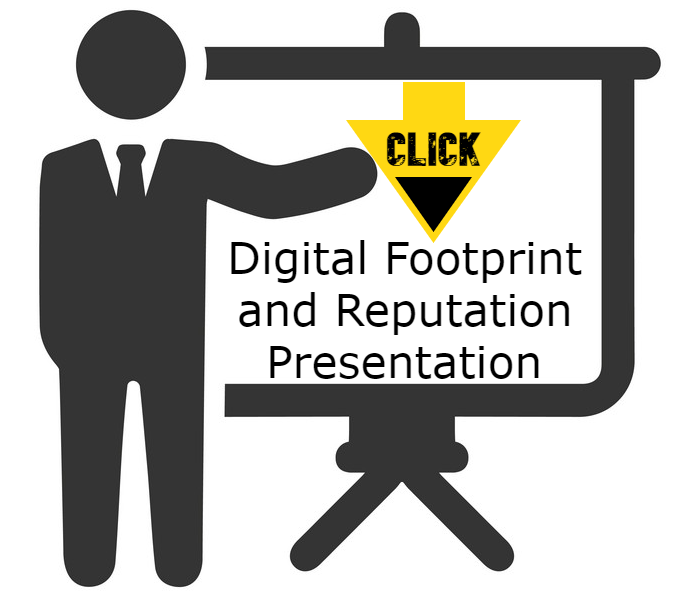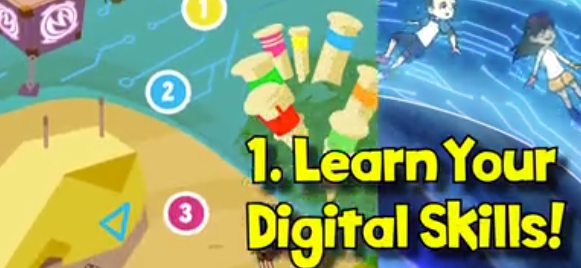Click tabs and you’ll find here activity guides links video quiz game about the topic
A digital footprint is a collection of personal data you leave behind while using the internet, like where you live, what products you buy, your email address, and more. It includes information you actively share through social media posts, blog profiles, and online forms, as well as data companies, collects on you through cookies and tracking scripts.
Most of us use the Internet as a way to connect with friends, explore topics, or study for school. Many are connected to multiple social media platforms including Facebook, Twitter, and Instagram. We share various pieces of our lives online, from our weekend plans to photos of the last food we ate If the digital footprint you are creating lasts a lifetime, is it one you’ll be proud to share? Even more immediate, is your online reputation one you’re willing to share with college admissions or future employers?
5 STEPS YOU CAN TAKE TO PROTECT YOUR DIGITAL FOOTPRINT
- Practice good digital hygiene.
- Adjust your browser settings.
- Maintain separate accounts.
- Muddle your digital profile.
- Request third-party websites to remove your personal information.
“For the average person, I believe it will change your behavior in terms of what you’re sharing,” Van Dyke said. “You’ll see what’s out there and if you take a few minutes to think about how some of that data got out there, you’ll realize that it was something you shared.”
Below are a few steps you can take to protect your personal data and limit your exposure
Minimize your online footprint with ideas to safeguard your data from cyber thieves.
Delete old email accounts
If hackers gain access to an email account you no longer use, they can view contacts, credibly impersonate you, search for personal information and try the same password on other accounts. If you are not regularly using the email address, it may take time for you to notice, leaving even more opportunity for damage.
Limit social media to reduce a digital footprint
For many people, deleting social media accounts entirely is not practical or even preferable. Instead, minimize both exposure and the data you share with others by limiting posts to “friends only,” turning off location data collection and clicking options to remove your profile from public search engine results. However, if there are accounts you no longer use, deactivate them.
Skip the survey
Steer clear of clickbait questionnaires on random websites. It’s simply another way for companies to gather digital insights into you.
Create a spam email address
Create an account specifically for marketing and other promotions such as store discounts, and limit any identifying information you store on that email account. That way, if a marketing database is breached and your account is compromised, you can simply delete it to try to minimize the loss of digital information. (Bonus: You’ll drastically cut down on the amount of spam in your “real” email.)
Remove yourself from people search sites
With a few clicks — and usually a few dollars — anyone can learn the names, addresses, telephone numbers and other information about millions of people through online data brokers (often called “people search” sites). And if you become the target of malicious online trolls, they can rapidly spread this information, potentially resulting in ongoing harassment. When you order online or sign up for newsletters or other communications, click the “opt out” button so that sites cannot share your information with marketing database companies. In addition, you can work with online data brokers to opt out. Search for “online data brokers” for a list. Each has different steps — including letters, faxes or other formal requests — to remove yourself, but it may be worth the effort.
Set up stealth mode when you search
Browsers enable you to set up stealth or incognito mode, which allows you to use the internet without saving information to your computer. Search for specific directions based on the browser you use the most.
The best place to start is to do a quick search on yourself using your name and current city, Van Dyke said. This will show you just how public and access your personal information might be.
Reference:
“What Is a Digital Footprint?” Built In, https://builtin.com/cybersecurity/digital-footprint.
“What Is Your Digital Footprint?” Cyberpedia, https://www.bitdefender.com/cyberpedia/what-is-digital-footprint/.
Things to Consider
Here are some things to consider to safeguard your online identity and reputation:
Remember that nothing is temporary online. The online world is full of chances to interact and share with others. It’s also a place where nothing is temporary and there are no “take-backs.” A lot of what you do and say online can be seen even if you delete it — and it’s a breeze for others to copy, save, and forward your information.
Mark your profiles as private. Anyone who accesses your profile on social networking sites can copy or screen-grab information and photos that you may not want the world to see. Don’t rely on the site’s default settings. Read each site’s guidelines to make sure you’re doing everything you can to keep your material private.
Safeguard your passwords and change them often. If someone logs on to a site and pretends to be you, they can trash your identity. Pick passwords that no one will guess and change them often. Never share them with anyone other than your parents or a trusted adult. Not even your best friend, boyfriend, or girlfriend should know your private passwords!
Don’t post inappropriate or sexually provocative pictures or comments. Things that seem funny or cool to you right now might not seem so cool years from now — or when a teacher, admissions officer, or potential employer sees them. A good rule of thumb is: if you’d feel weird if your grandmother, coach, or best friend’s parents saw it, it’s probably not a good thing to post. Even if it’s on a private page, it could be hacked or copied and forwarded.
Don’t respond to inappropriate requests. Many teens get inappropriate messages and solicitations when they’re online. These can be scary, strange, and even embarrassing. If you feel harassed by a stranger or a friend online, tell an adult you trust immediately. It is never a good idea to respond. Responding is only likely to make things worse, and might result in you saying something you wish you hadn’t.
Take a breather to avoid “flaming.” Feel like firing off an angry text or comment? Wait a few minutes, calm down, and remember that the comments may stay long after you’ve regained your temper or changed your mind.
Feeling anonymous on social networks or other sites can make people feel OK about posting mean, insulting, or abusive comments. Sharing stuff or making angry comments when we’re not face to face with someone can be hurtful and damage how others see us if they find out. A good rule to remember: if you wouldn’t say it, show it, or do it in person, you don’t want to online.
Respect copyrights. Know about copyright laws and make sure you don’t post, share, or distribute copyrighted images, songs, or files. Sure, you want to share them, but you don’t want to do anything illegal that can come back to haunt you later.
Check yourself. Check your “digital footprint.” Try typing your screen name or email address into a search engine and see what comes up. That’s one way to get a sense of what others see as your online identity.
Take it offline. In general, if you have questions about the trail you’re leaving online, don’t be afraid to ask a trusted adult. Sure, you might know more about the online world than a lot of adults do, but they have life experience that can help.
Your online identity and reputation are shaped in much the same way as your real-life identity. But when you’re online you don’t always get a chance to explain your tone or what you mean. Thinking before you post and being responsible can help you avoid leaving an online identity trail you regret.
○What is a digital footprint?
○What is your digital footprint and reputation?
○What does it mean that the internet is public and permanent?
○Who looks at your digital footprint and reputation?
○What are some recommended social media guideline?
○How can you maintain your digital footprint?
○What does your digital footprint say about you?
Exercise: What is your Digital Footprint?
Search for yourself on Google. If you have a common name, you might need to search for your name and the city you live in. For example Joanne Smith San Francisco.
- What comes up in your Google search?
- What was the most surprising thing that you noticed?
- What are some actions you should take to maintain a positive digital footprint?
Search some specific sites
There are many sites dedicated to gathering/aggregating all of the publicly available information about people. For example, see what you can find out about yourself at:





